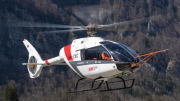Leonardo announces the next updates for the Eurofighter Typhoon’s DASS protection system
Leonardo, within the EuroDASS consortium (Leonardo, ELT Group, Indra and Hensoldt), has announced the next package of updates for the Eurofighter Typhoon’s DASS (Defensive Aids Sub-System) protection system. The activities build on the advances in technological development achieved thanks to the continued investment of the EuroDASS consortium partners in the aircraft’s defensive capabilities. With the aim of meeting the needs of pilots and operators of the Typhoon, the updates have been proposed as part of the “Phase 4 Enhancement” package of the four partner nations of the Eurofighter program (UK, Italy, Germany and Spain) and will be available also for export customers.
This latest upgrade will increase the survivability of the aircraft and will also lay the groundwork for defense system integration with the Typhoon’s high-capacity E-scan radars. The update covers all versions of the Typhoon’s electronically scanned radar, including those already in service and variants currently under development by Eurofighter partner countries. The current DASS protection system, called Praetorian, protects the Typhoon from threats such as infrared and radar-guided missiles. The system’s integrated sensors and jamming equipment provide the pilot with a complete picture of the situation and equip the aircraft with digital stealth capability, achieved through advanced electronic deception techniques.
This last phase will see the EuroDASS partners integrate into the Praetorian system a number of new capabilities, already in an advanced stage of development. Among these, a digital receiver functionality that will allow the Typhoon to better recognize complex targets and their operating modes, allowing the aircraft to respond with the appropriate countermeasures. System update DASS protection also incorporates a band extension that will allow the Typhoon to continue to operate in increasingly complex and congested operating theaters, also from an electromagnetic point of view. Also included are improvements to signal processing algorithms and processor capabilities, which will lead to major advances in processing speed, capacity and memory. This will allow the Praetorian system to take full advantage of integration with versions of Typhoon’s E-scan radar, including the new ECRS Mk2 radar currently under development for the UK Armed Forces.
The new sensor variants incorporate powerful electronic attack capabilities and will complement the jamming capabilities provided by the Praetorian system. Leonardo is integrating the Praetorian in Luton, UK, where it carries out research, development and production in the field of electronic warfare. The development of the digital receiver capability was led by the German partner Hensoldt, while the Spanish Indra continued the bandwidth extension work. Further improvements in countermeasures and other aspects will be led by ELT Group. At the Royal International Air Tattoo (RIAT) in Fairford, UK, Leonardo will showcase the new capabilities aboard a “Navajo” test aircraft operated by 2Excel, its test and evaluation partner.
The first flight tests with the aircraft equipped with the updated Typhoon hardware will take place immediately after RIAT. Other tests aboard Typhoon aircraft are scheduled for early 2024. Looking ahead, the EuroDASS partners are also carrying out the “Praetorian eVolution”, the roadmap for the future DASS of the Typhoon which will guarantee the aircraft to maintain, in decades to come, its technological edge. The roadmap defines new capabilities, including multi-platform electronic warfare and combat ISR features, such as high-precision targeting and advanced combat identification. The four Typhoon partner nations continue to discuss the evolution of the system, with the aim of maintaining solid skills in the domain of air combat and, in a context of growing threats, full autonomy for Typhoon operators. Fabio Gigante for AeroMorning








Be the first to comment on "Eurofighter Typhoon’s DASS protection system"